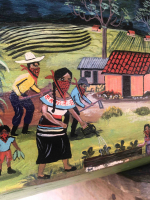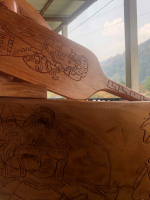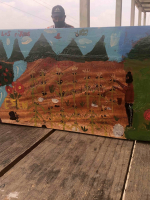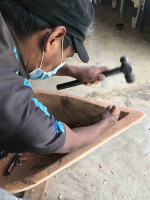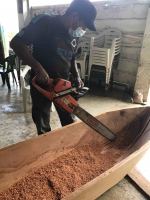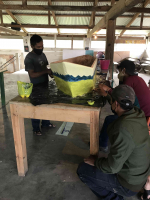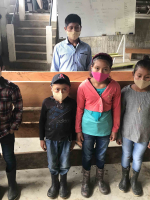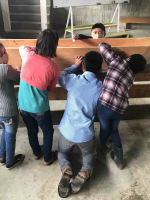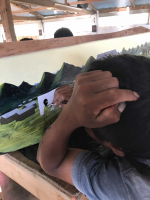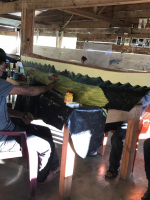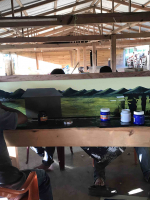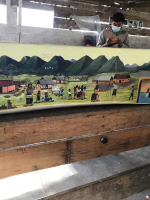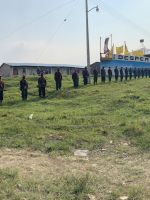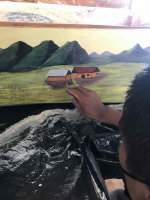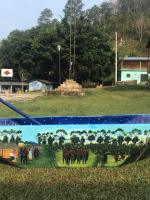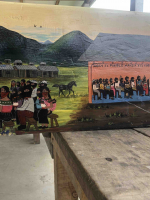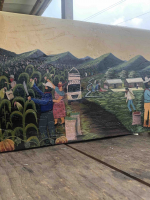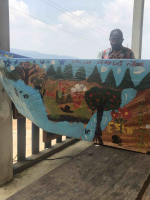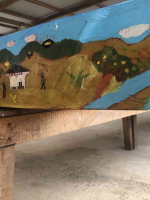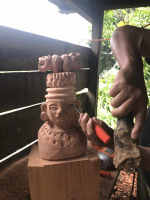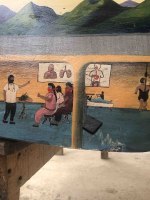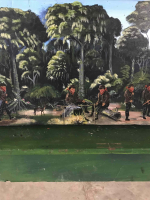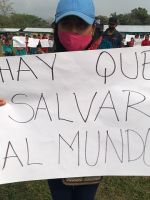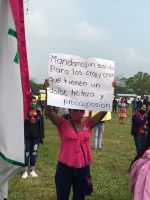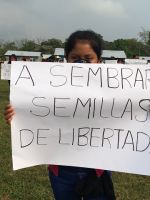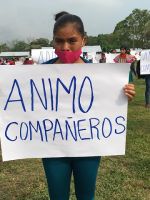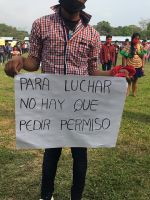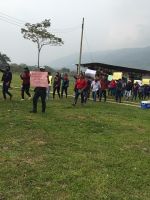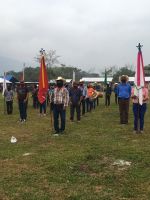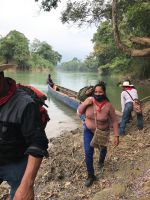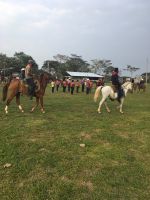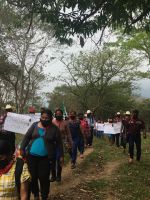
The Azores Islands, Portugal, Europe
THE AZORES ISLANDS, PORTUGAL, EUROPE
June 11, 2021.
(Note: Times and dates are in accordance with Mexican geography.)
With a dusty face, a cleaned and refreshed exterior, and repaired sails, La Montaña departed Cienfuegos, Cuba, on May 16 and headed East. Skirting along the edge of the Las Coloradas beach, with the Sierra Maestra mountains to its left, the ship was accompanied once again by the dolphins convoked by Durito Stahlkäfer, who cursed as the vessel passed the US aberration in Guantánamo. They were greeted by whales near Haiti, and Durito and the Cat-Dog disembarked on Tortuga Island[i] mumbling something about buried treasure… or treasure to be buried. In support of the support team, Lupita, Ximena and Bernal amicably threw up, though they would have preferred to offer support some other way. In Punta Rucia, Dominican Republic, La Montaña docked and waited cautiously for strong winds to pass. On May 24, at daybreak and propelled by its sails alone (“as not to scare the wind,” Captain Ludwig said), La Montaña set off northwards. This time orcas greeted the ship, waving farewell as it departed Caribbean waters. Between May 25 and 26, the schizophrenic ship [el navío] – who thinks he is a she as well as a mountain – navigated around the Bahamas and on May 27 turned Northeast, now on the open ocean, Duc in Altum[ii].
On June 4, having exited the so-called Bermuda Triangle, the ship and its esteemed crew reoriented East toward the rising sun. Between June 5-9, they navigated waters where, according to legend, the mythical city of Atlantis lies.
It was 22:10:15hrs on June 10 when, through the haze of the European dawn, from the top of La Montaña’s crow’s nest, the outlines of a sister mountain became discernable: Cabeço Gordo on Faial Island in the Azores Archipelago, autonomous region of the geography of Portugal, in Europe.
It was 02:30:45hrs on June 11 when the coast of the port of Horta came into view, just a stone’s throw away, bringing tears to the eyes of the crew and passengers. It was 7:30am in the Azores mountains. It was 03:45:13hrs when a port authority motorboat approached La Montaña to indicate where to drop anchor. At 04:15:33hrs the shop dropped anchor in front of the other mountains. At 08:23:54hrs the Port Captaincy picked up the crew members of La Montaña and took them to shore for Covid PCR tests, and returned them to the boat to await the results. At all times the “Autoridade Maritima” of the port of Horta was friendly and respectful.
The crew and passengers are in good health, “in good spirits, happy, with no problems, gossip, or fighting. (In the 421st Squadron) they take care of each other.”
It is now time to tell you who else, besides the crew of the Stahlratte and the Zapatista 421st Squadron, have made the voyage. Tasked with documenting the maritime journey are María Secco, independent filmmaker and photographer, and Diego Enrique Osorno, independent reporter. In the role of support team for the Zapatista delegation is Javier Elorriaga.
In accordance with the traditional Zapatista ways and customs, and in addition to paying their own expenses, these three people were required to show written authorizations from their families, partners and children. Each letter was presented to Subcomandante Insurgente Moisés. Wives, husbands, mothers, sons and daughters wrote and signed the authorization letters. I got to read them. There was a little bit of everything, from philosophical reflections to children’s illustrations, including a little girl’s respectful request for a whale. Nobody requested beetles or cat-dogs, which is either an affront or a relief, I’m not quite sure. In the children’s writing you could detect pride in the fact that their mother or father had to ask permission from them (as the Zapatista saying goes: “the ducks shoot at the rifles.”[iii]) I imagine you will have the opportunity to get to know María and Diego’s observations, their anecdotes, their reflections and their assessment of their participation on “the front lines” (both are filmmakers) of this delirium. New gazes are always welcome and are refreshing.
-*-
When this news arrived in the mountains of Southeastern Mexico, the Zapatista communities sent a message to the crew of the Stahlratte via the captain: “Thank you, you all are fucking awesome.” They are still trying to translate it into German.
-*-
Something to reflect on: the motto of the Azores is “Antes morrer livres que em paz sujeitos” (Better to die free than live in peace as slaves).
-*-
In the distance, to the East, the Pillars of Hercules – which in their day were the limits of the known world – gazed in astonishment on a mountain that has made a journey by sea from the West.[iv]
I testify.
SupGaleano.
June 11, 2021
[i]Small island off the northwest coast of Haiti which was a major center of Caribbean piracy in the 17th century.
[ii]“Duc in altum et laxate retia vestra in capturam” – “Cast out into the deep, and let down your nets for a catch” (Luke 5:4).
[iii]Phrase used when a subordinate attempts to go over the head of his/her boss.
[iv]The Pillars of Hercules was the name given in ancient times to the rocky mountains at the edge of the Strait of Gibraltar.
(Español) Contra la represión de los malos gobiernos. Apoyo a la Escuela Normal Rural Mactumactzá en Chiapas y a los pueblos Tepehuano y Wixárika en Jalisco
CONTRA LA REPRESIÓN DE LOS MALOS GOBIERNOS.
APOYO A LA ESCUELA NORMAL RURAL MACTUMACTZÁ EN
CHIAPAS Y A LOS PUEBLOS TEPEHUANO Y WIXÁRIKA EN JALISCO.
CNI-CIG Y EZLN.
Mayo del 2021.
A la Escuela Normal Rural Mactumactzá, Chiapas.
A los pueblos tepehuano y wixárika de San Lorenzo de Azqueltán, Jalisco.
A las organizaciones y colectivos de derechos humanos.
A la Sexta Nacional e Internacional.
A los medios de comunicación.
Como pueblos originarios que somos, organizados en el Congreso Nacional Indígena-Concejo Indígena de Gobierno y el EZLN, declaramos lo siguiente:
PRIMERO.- Expresamos nuestro repudio a las acciones represivas del mal gobierno en contra de nuestros hermanos de la Escuela Normal Rural Mactumactzá. Una vez más con lujo de violencia se busca acallar las justas demandas de los normalistas. El 18 de mayo el mal gobierno detuvo a 91 normalistas, incluyendo a 74 mujeres estudiantes. Éstas han denunciado que los cuerpos policiacos represivos las vieron como botín de guerra y las hostigaron sexualmente desnudándolas y manoseándolas. L@s normalistas son acusad@s de querer que los exámenes, que les iban a practicar, sean de manera presencial y no por internet. Con esto las autoridades educativas y gubernamentales de Chiapas muestran, una vez más que no tienen la menor idea de la geografía y la situación política y social en el estado. Con esta acción, los malos gobiernos resumen su plan para la educación del México rural: represión, mentiras y simulación. A nuestr@s herman@s de la Escuela Normal Rural Mactumactzá les manifestamos nuestra solidaridad completa y sin reservas; y llamamos a tod@s nuestr@s compañer@s de la Sexta Nacional e Internacional a solidarizarse con la lucha de los normalistas de Mactumactzá. Exigimos la liberación incondicional de tod@s l@s detenido@s
SEGUNDO.- Como Congreso Nacional Indígena-Concejo Indígena de Gobierno y EZLN saludamos la Campaña Nacional e Internacional por la Justicia y el Territorio en Azquetltán, municipio de Villa Guerrero, en el estado de Jalisco, México. Ahí resisten por la vida las hermanas y hermanos de la comunidad indígena autónoma, wixárika y tepehuana.





